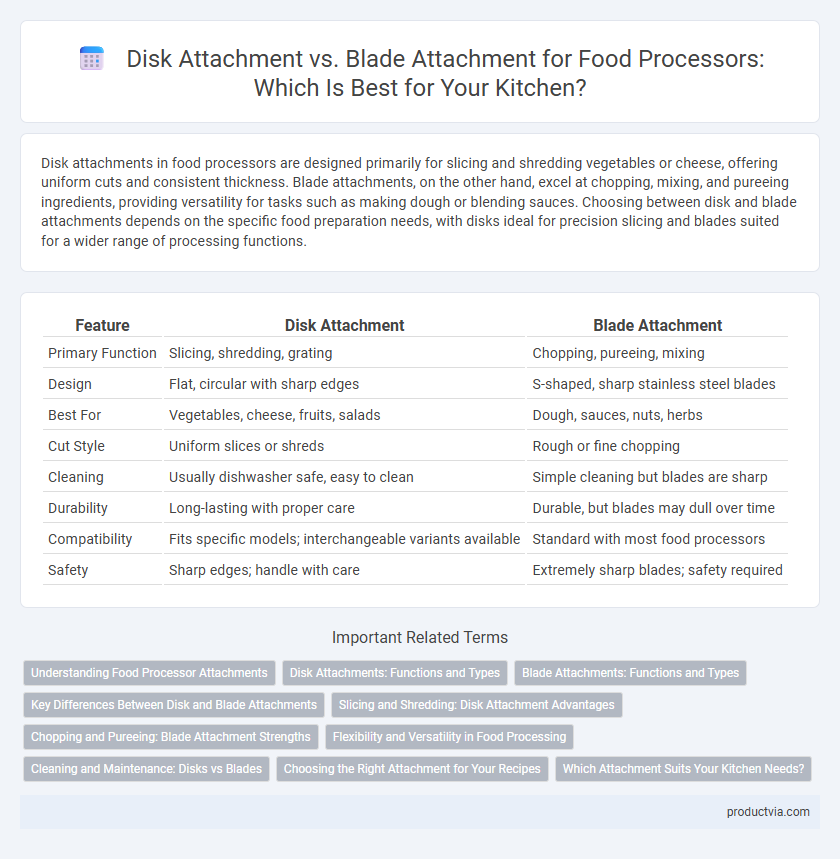Disk attachments in food processors are designed primarily for slicing and shredding vegetables or cheese, offering uniform cuts and consistent thickness. Blade attachments, on the other hand, excel at chopping, mixing, and pureeing ingredients, providing versatility for tasks such as making dough or blending sauces. Choosing between disk and blade attachments depends on the specific food preparation needs, with disks ideal for precision slicing and blades suited for a wider range of processing functions.
Table of Comparison
| Feature | Disk Attachment | Blade Attachment |
|---|---|---|
| Primary Function | Slicing, shredding, grating | Chopping, pureeing, mixing |
| Design | Flat, circular with sharp edges | S-shaped, sharp stainless steel blades |
| Best For | Vegetables, cheese, fruits, salads | Dough, sauces, nuts, herbs |
| Cut Style | Uniform slices or shreds | Rough or fine chopping |
| Cleaning | Usually dishwasher safe, easy to clean | Simple cleaning but blades are sharp |
| Durability | Long-lasting with proper care | Durable, but blades may dull over time |
| Compatibility | Fits specific models; interchangeable variants available | Standard with most food processors |
| Safety | Sharp edges; handle with care | Extremely sharp blades; safety required |
Understanding Food Processor Attachments
Disk attachments for food processors specialize in slicing and shredding vegetables, cheese, and fruits with precision and uniformity, enhancing food texture and presentation. Blade attachments excel in chopping, mixing, pureeing, and kneading, providing versatility for various recipes such as dough, sauces, and dips. Understanding the specific functions of disk versus blade attachments optimizes food preparation efficiency and culinary results.
Disk Attachments: Functions and Types
Disk attachments for food processors offer specialized functions such as slicing, shredding, grating, and julienning, enhancing versatility in food preparation. Common types include slicing disks with adjustable thickness settings, shredding disks for coarse or fine textures, and julienne disks that create uniform, matchstick-sized cuts. These attachments enable precise and consistent results, making them ideal for salads, garnishes, and ingredient preparation requiring uniformity.
Blade Attachments: Functions and Types
Blade attachments for food processors serve versatile functions including chopping, slicing, shredding, and pureeing ingredients efficiently. Common types include S-shaped blades for general chopping and mixing, shredding discs for finely grating vegetables and cheese, and slicing discs for uniform vegetable or fruit slices. High-quality stainless steel blades ensure durability and precision, enhancing overall food preparation performance.
Key Differences Between Disk and Blade Attachments
Disk attachments in food processors are designed primarily for slicing, shredding, and grating, providing uniform cuts with specific thicknesses, while blade attachments focus on chopping, mixing, and pureeing ingredients with versatile sharp edges. Disk attachments rotate at high speeds on a flat surface, ideal for producing consistent textures for vegetables and cheese, whereas blade attachments operate with a multi-tiered, sharp-edged design suitable for breaking down tougher or larger food items. Understanding these functional differences can optimize food preparation by selecting the appropriate attachment for specific culinary tasks.
Slicing and Shredding: Disk Attachment Advantages
Disk attachments for food processors offer superior slicing and shredding capabilities compared to blade attachments, providing uniform and consistent cuts for vegetables, fruits, and cheese. Their design allows for adjustable thickness settings, enabling precise control over the texture and size of food slices or shreds. Disk attachments also enhance efficiency by processing larger quantities faster, making them ideal for tasks like preparing salads, gratins, and coleslaws.
Chopping and Pureeing: Blade Attachment Strengths
Blade attachments in food processors excel at chopping and pureeing tasks due to their sharp, multi-level design that ensures uniform ingredient processing. These blades efficiently handle nuts, vegetables, and fruits, producing consistent textures ranging from coarse chops to smooth purees. Their stainless steel construction enhances durability and maintains sharpness, making them ideal for versatile kitchen applications.
Flexibility and Versatility in Food Processing
Disk attachments offer superior flexibility for slicing, shredding, and grating tasks, allowing users to quickly switch between different textures and thicknesses. Blade attachments excel in versatility by handling chopping, pureeing, and kneading, making them essential for diverse food preparation needs. Choosing between disk and blade attachments depends on whether the focus is on precise cutting options or multifunctional processing capabilities.
Cleaning and Maintenance: Disks vs Blades
Disk attachments in food processors often require more meticulous cleaning due to their multiple layers and sharp edges that can trap food particles, while blade attachments generally have a simpler design that allows for quicker and easier rinsing. Maintaining disks involves careful handling to prevent bending or dulling, impacting slicing or shredding efficiency, whereas blades demand regular sharpening to preserve cutting performance. Proper cleaning and maintenance of both attachments are essential to ensure food safety and prolong the lifespan of the food processor components.
Choosing the Right Attachment for Your Recipes
Disk attachments excel at slicing, shredding, and grating vegetables and fruits with uniform precision, making them ideal for salads and garnishes. Blade attachments are designed for chopping, mixing, and pureeing, perfect for creating dough, sauces, and finely processed ingredients. Selecting the right attachment depends on the texture and consistency required by your recipe to achieve optimal results efficiently.
Which Attachment Suits Your Kitchen Needs?
Disk attachments excel at slicing, shredding, and grating, ideal for preparing vegetables and cheese with consistent thickness. Blade attachments offer versatile chopping, blending, and pureeing capabilities, perfect for making dough, sauces, and soups. Choosing between disk and blade attachments depends on your typical recipes and food preparation preferences, ensuring efficient kitchen workflow.
Disk attachment vs Blade attachment for food processor Infographic

 productvia.com
productvia.com